The concept of the ‘right to die’ is fraught with controversy and legal issues. Euthanasia, or the practice or act of bringing about the painless death of a hopelessly sick or injured individual, and assisted suicide, in which a physician or other health care professional assists a patient with causing his or her own death, are two main ideas involved in the discussion of the right to die. Euthanasia is divided into two categories: passive, in which something is not done that would preserve a patient’s life, and active, in which something is done to end a patient’s life.
Currently, euthanasia is legal in the Netherlands, Belgium, Colombia, Luxembourg, and Canada. Assisted suicide is legal in Switzerland, Germany, the Netherlands, and in the U.S. states of Washington, Oregon, Colorado, Hawaii, Vermont, Montana, and Washington, D.C. The Australian state of Victoria expects to legalize euthanasia by mid-2019.
The Controversy over the Right to Die
Proponents of euthanasia and assisted suicide contend that it gives those who suffer from a terminal illness the ability to die with dignity. They further argue that one should have the right to decide how and when to die when faced with the imminent reality of suffering and a diminished quality of life. Opponents state that the concept is dangerous and unethical, and that doctor-induced death could be sought out for conditions like depression and other forms of mental illness (as permitted in the Netherlands) or be available to children (as is allowed in Belgium). The debate is likely to continue indefinitely, so let’s review key U.S. Supreme Court cases on this topic in HeinOnline.
1. Cruzan v. Director, Missouri Department of Health (497 U.S. 261):
In 1983, Nancy Beth Cruzan was involved in an automobile accident which left her in a persistent vegetative state. She was sustained for several weeks by artificial feedings through an implanted gastronomy tube. When Cruzan’s parents attempted to terminate the life-support system, state hospital officials refused to do so without court approval. The Missouri Supreme Court ruled in favor of the state’s policy over Cruzan’s right to refuse treatment. In a 5-4 decision, the U.S. Supreme Court held that incompetent persons are not able to exercise the right to refuse medical treatment. Because there was no clear evidence that Cruzan desired her treatment to be withdrawn, the Court found that Missouri’s actions aimed at preserving human life were constitutional. Find this case by entering its citation into the Full Text tab located on the HeinOnline Welcome page. The very first result is the case.
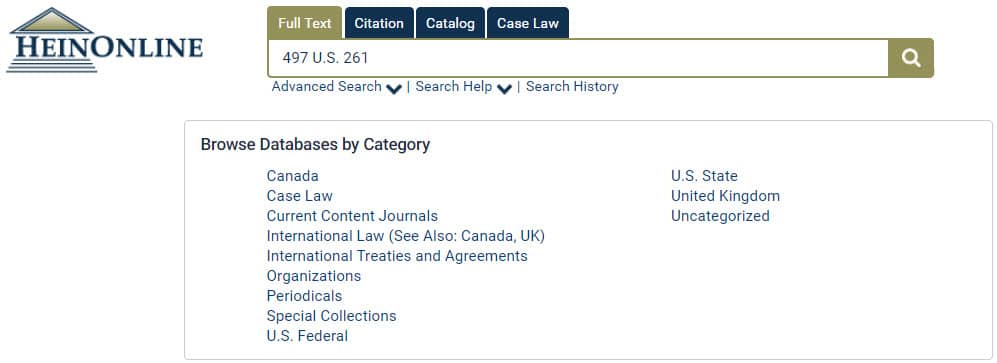
2. Washington v. Glucksberg (521 U.S. 702):
Dr. Harold Glucksberg and four other physicians, three terminally ill patients, and a nonprofit organization that counsels individuals contemplating physician-assisted suicide brought this suit challenging the state of Washington’s ban on the practice as unconstitutional. The case questioned whether the ban violated the Fourteenth Amendment of the U.S. Constitution by denying mentally competent, terminally ill adults the freedom to choose death over life. Chief Justice Rehnquist wrote the majority opinion for the Court. As previously decided in Moore v. East Cleveland, the Court believed that assisted suicide was not protected under the Fourteenth Amendment because it is not a fundamental liberty interest. Users can find this case by entering the case citation into the Citation tab from anywhere in HeinOnline.

3. Gonzales v. Oregon (546 U.S. 243):
The state of Oregon enacted the Death with Dignity Act in 1994, the first state law authorizing physicians to prescribe lethal doses of controlled substances to terminally ill patients. Two doctors must agree that the patient has an incurable condition that leaves him or her with less than six months to live. In 2001, Attorney General John Ashcroft said that Oregon’s law legalizing physician-assisted suicide violated the Controlled Substances Act of 1970 (CSA). He then threatened to revoke the medical licenses of any physician who took part in the practice. Oregon sued Ashcroft in federal district court. The question for this case was whether or not the CSA authorized the Attorney General to ban the use of controlled substances for physician-assisted suicide in Oregon. The court ruled in favor of Oregon, stating that the CSA did not give the Attorney General the power to interfere with physicians who are obeying the state law. Listen to audio recording of this case’s oral arguments by clicking the Oyez icon found in HeinOnline.

4. Vacco v. Quill (521 U.S. 793):
New York state banned physician-assisted suicide, making it a crime for a physician to administer lethal medication or to otherwise knowingly and intentionally end the life of a patient, even a consenting, mentally competent, and terminally ill patient. Dr. Timothy Quill, along with other physicians of seriously ill patients, challenged the ban. They argued the statute violated the Equal Protection Clause of the Fourteenth Amendment. The Court ruled 9-0 that the New York ban on physician-assisted suicide was constitutional. The decision established that there was no constitutional guarantee of a ‘right to die.’ To view this case, enter the case citation into the Case Law tab in HeinOnline. If a case is available in both HeinOnline and Fastcase, users are prompted to choose which version they would like to view.

In both HeinOnline and Fastcase, users can view the articles and cases which cite the case being researched. HeinOnline implemented the ScholarCheck features in cases from Fastcase, and an example is shown below. Find the box in the upper right-hand corner.
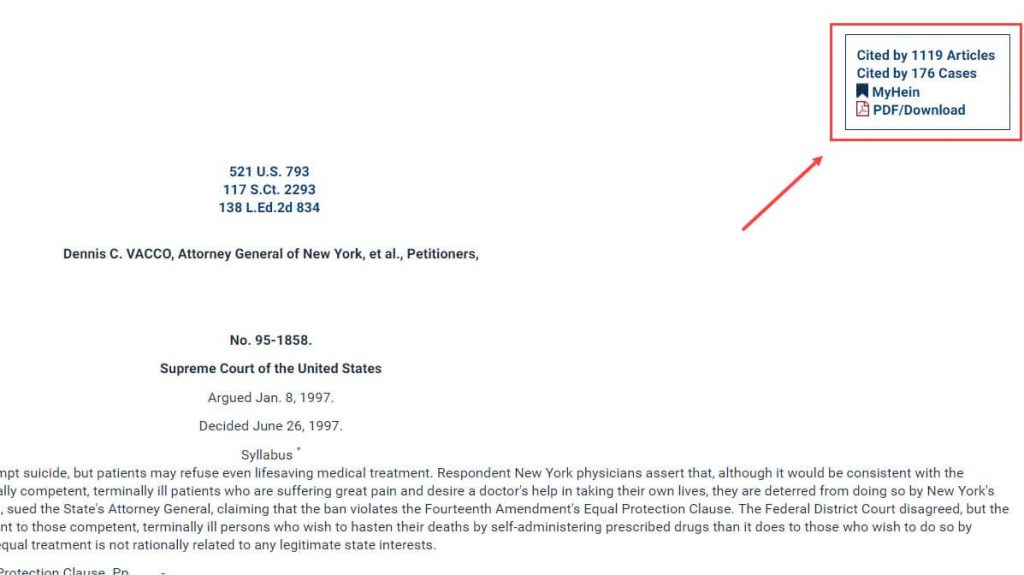
Research Topics in the Law Journal Library
Let’s research this topic using the Law Journal Library. Click on the Advanced Search option within this database. Enter the phrase “right to die” in the Article Title field and enter Euthanasia into the Topics field. Then, click the search button.
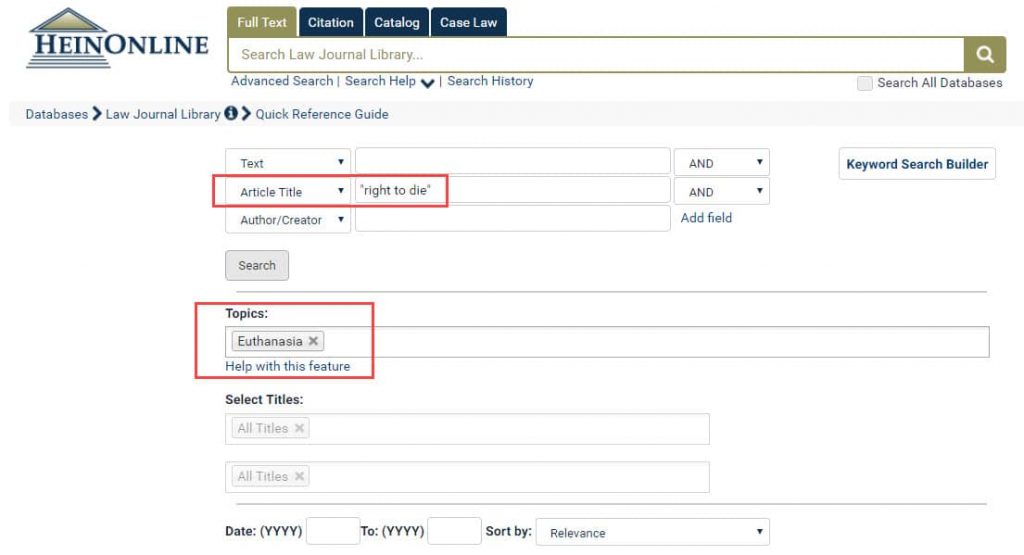
From the results page, Sort by Number of Times Sorted by Articles. The first article listed, titled The “Right to Die” in America: Sloganeering from Quinlan and Cruzan to Quill and Kevorkian, directly relates to one of the cases mentioned earlier. Click the More Like This button to view similar articles. This tool uses a program which pulls out “interesting words,” as determined by an algorithm, from the article being viewed. Users are provided with a list of similar articles based on the interesting words.
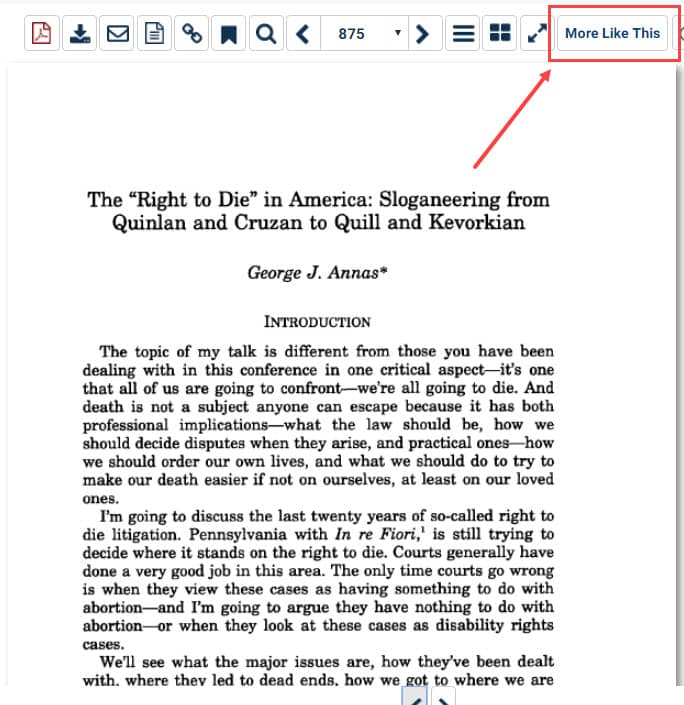
Adjust the boost factors of the interesting words, add a new term, or select a date range to change the scope of results.
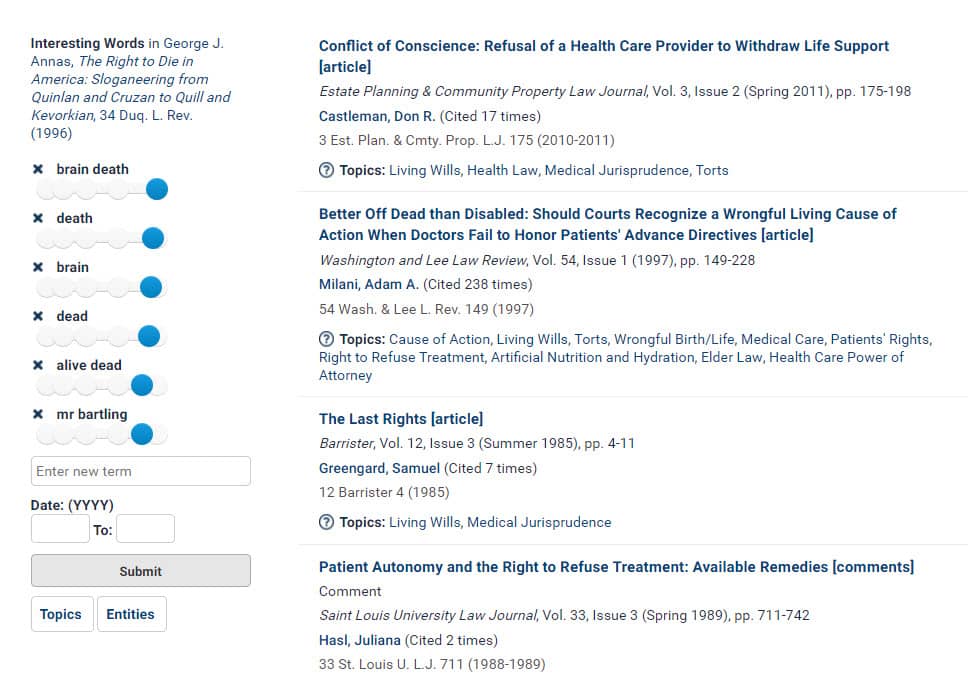
For help searching or navigating in HeinOnline, contact our dedicated support team at (800) 277-6995, email us, or chat with us!
Stay in the know with HeinOnline and connect with us on social media platform: Facebook, Twitter, Instagram, and YouTube.



